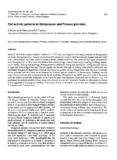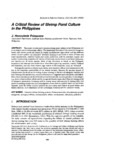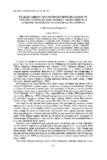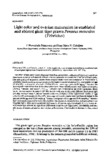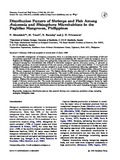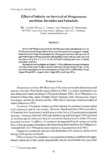Search
Now showing items 1-10 of 11
Intensive prawn farming in the Philippines: ecological, social, and economic implications
(Springer Verlag, 1991)
The benefits of intensive farming of the giant tiger prawn Penaeus monodon in the Philippines are discussed in relation to the environmental costs. Ecological effects include mangrove conversion into ponds; use of antibiotics ...
Diel activity patterns in Metapenaeus and Penaeus juveniles
(Springer Verlag, 1995)
Small (5–10.9 mm carapace length), medium (11–15.9 mm), and large (16–20.9 mm) juveniles of Metapenaeus anchistus, Metapenaeus sp., Penaeus monodon and P. merguiensis were stocked individually in glass tanks provided with ...
A critical review of shrimp pond culture in the Philippines
(Taylor & Francis, 1993)
The paper reviews and evaluates shrimp pond culture in the Philippines and its ecological and socioeconomic effects. The intertwined histories of the country's mangrove forests and culture ponds are treated in depth; ...
Stable carbon and nitrogen isotope ratios of penaeid juveniles and primary producers in a riverine mangrove in Guimaras, Philippines
(University of Miami, Rosenstiel School of Marine and Atmospheric Science, 1996)
Stable carbon and nitrogen isotope ratios were analyzed for primary producers and juveniles of four penaeid species (Metapenaeus ensis, Penaeus indicus, P. merquiensi and P. monodon) in a riverine mangrove in Guimaras, ...
Socio-economic impacts of shrimp culture
(Blackwell Publishing, 1997)
Farmed shrimp contributed 27% of total world shrimp production in 1995 with a volume of 712 000 tonnes. Undoubtedly, the shrimp culture industry earns valuable foreign exchange for developing countries and generates jobs ...
Light color and ovarian maturation in unablated and ablated giant tiger prawn Penaeus monodon (Fabricius)
(Elsevier, 1992)
The effect of light color (green, blue and white fluorescent lights, with natural light as a control) on maturation in intact and eyestalk-ablated Penaeus monodon was tested in 12-m<sup>3</sup> broodstock tanks. Size and ...
Distribution pattern of shrimps and fish among Avicennia and Rhizophora microhabitats in the Pagbilao mangroves, Philippines
(Elsevier, 1999)
For sustainable management of mangrove ecosystems, there is a pressing need to increase our knowledge of fish and invertebrates associated with this system. This study sampled microhabitats (89–258 m<sup>2</sup>) ...
Nature's subsidies to shrimp and salmon farming
(American Association for the Advancement of Science, 1998)
Although many fisheries stocks have declined precipitously throughout the world, fish farming--and especially shrimp and salmon farming--has boomed. The increasingly large scale of these enterprises is now having unforeseen ...
Mangroves and brackishwater pond culture in the Philippines
(Springer Verlag, 1995)
Around 50% of mangrove loss in the Philippines can be traced to brackishwater pond construction. The decrease in mangroves from 450 000 ha in 1920 to 132 500 ha in 1990 has been accompanied by expansion of culture ponds ...
Effect of salinity on survival of Metapenaeus anchistus juveniles and subadults
(University of the Philippines in the Visayas, 1997)
Survival of Metapenaeus anchistus (De Man) juveniles and subadults at 5, 15, 25, 35 (control) and 45 ppt salinity levels was determined and compared. Salinity levels lower than 35 ppt level were prepared by diluting pure ...



